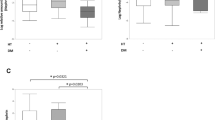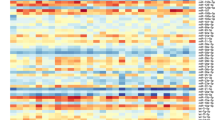Abstract
Background
The effective maintenance of genome integrity and fidelity is vital for the normal function of our tissues and organs, and the prevention of diseases. DNA repair pathways maintain genome stability, and the adequacy of genes acting in these pathways is essential for disease suppression and direct treatment responses. Chronic kidney disease is characterized by high levels of genomic damage. In this study, we examined the expression levels of the xeroderma pigmentosum group D (XPD) gene, which plays a role in the nucleotide excision repair (NER) repair mechanism, and the expression levels of miR-145 and miR-770 genes, which play a role in the regulation of the expression of the XPD gene, in hemodialysis patients with (n = 42) and without malignancy (n = 9) in pre- and post-dialysis conditions. We also evaluated these values with the clinical findings of the patients.
Methods & Results
Gene expression analysis was performed by real-time polymerase chain reaction (qRT-PCR). Compared to the individuals with normal kidney function (2.06 ± 0.32), the XPD gene expression was lower in the pre-dialysis condition both in hemodialysis patients without cancer (1.24 ± 0.18; p = 0.02) and in hemodialysis patients with cancer (0.82 ± 0.114; p = 0.001). On the other hand, we found that miR-145 and miR-770 expression levels were high in both groups. We also found that expression levels were affected by dialysis processes. A statistically significant positive correlation was found between miR-145 and mir770 expression levels in the pre-dialysis group of patients with (r=-0.988. p = 0.0001) and without (r=-0.934. p = 0.0001) malignancy.
Conclusions
Studies on DNA damage repair in the kidney will help develop strategies to protect kidney function against kidney diseases.
Similar content being viewed by others
Data Availability
The data of the study are available upon request from the corresponding author.
References
Obrador GT, Schultheiss UT, Kretzler M, Langham RG, Nangaku M, Pecoits-Filho R, Pollock C, Rossert J, Correa-Rotter R, Stenvinkel P, Walker R, Yang CW, Fox CS, Köttgen A (2011) Genetic and environmental risk factors for chronic kidney disease. Kidney Int Suppl 2017:88–106. https://doi.org/10.1016/j.kisu.2017.07.004
Rangel-López A, Paniagua-Medina ME, Urbán-Reyes M, Cortes-Arredondo M, Alvarez-Aguilar C, López-Meza J, Ochoa-Zarzosa A, Lindholm B, García-López E, Paniagua JR (2013) Genetic damage in patients with chronic kidney disease, peritoneal dialysis and haemodialysis: a comparative study. Mutagenesis 28: 219 – 25. https://doi.org/10.1093/mutage/ges075
Guven GS, Altiparmak MR, Trabulus S, Yalin AS, Batar B, Tunckale A, Guven M (2013) Relationship between genomic damage and clinical features in dialysis patients. Genet Test Mol Biomarkers 17:202–206. https://doi.org/10.1089/gtmb.2012.0301
Schupp N, Stopper H, Heidland (2016) DNA damage in chronic kidney disease: Evaluation of clinical biomarkers. Oxid Med Cell Longev 2016: 3592042. https://doi.org/10.1155/2016/3592042
Luciani A, Denley MCS, Govers LP, Sorrentino V, Froese DS (2021) Mitochondrial DNA mutations in renal disease: an overview. Cell Mol Life Sci 78:6851–6867. https://doi.org/10.1007/s00018-021-03934-3
Shirazian S, Starakiewicz P, Latcha S (2021) Cancer Screening in end-stage kidney disease. Adv Chronic Kidney Dis 28:502–508e1. https://doi.org/10.1053/j.ackd.2021.09.006
Vamvakas S, Bahner U, Heidlan A (1998) Cancer in end-stage renal disease: potential factors involved. Am J Nephrol 18:89–95. https://doi.org/10.1159/000013314
Hayashi K, Hishikawa A, Itoh H (2019) DNA damage repair and DNA methylation in the kidney. Am J Nephrol 50:81–91. https://doi.org/10.1159/000501356
Schmid U, Stopper H, Schweda F, Queisser N, Schupp N (2008) Angiotensin II induces DNA damage in the kidney. Cancer Res 68:9239–9246. https://doi.org/10.1158/0008-5472.CAN-08-1310
Duan M, Speer RM, Ulibarri J, Liu KJ, Mao P (2021) Transcription-coupled nucleotide excision repair: new insights revealed by genomic approaches. DNA Repair (Amst) 103:103126. https://doi.org/10.1016/j.dnarep.2021.103126
Vogel U, Dybdahl M, Frentz G, Nexo BA (2000) DNA repair capacity: inconsistency between effect of over-expression of five NER genes and the correlation to mRNA levels in primary lymphocytes. Mutat Res 461:197–210. https://doi.org/10.1016/s0921-8777(00)00051-3
Compe E, Pangou E, Le May N, Elly C, Braun C, Hwang JH, Coin F, Sumara I, Choi KW, Egly JM (2022) Phosphorylation of XPD drives its mitotic role independently of its DNA repair and transcription functions. Sci Adv 8:eabp9457. https://doi.org/10.1126/sciadv.abp9457
Franczyk B, Gluba-Brzózka A, Olszewski R, Parolczyk M, Rysz-Górzyńska M, Rysz J (2022) miRNA biomarkers in renal disease. Int Urol Nephrol 54:575–588. https://doi.org/10.1007/s11255-021-02922-7
Mutlu T, Ozoran E, Trabulus DC, Talu CK, Erhan D, Mete M, Guven M (2022) Expression of genes related to iron homeostasis in breast cancer. Mol Biol Rep 50:5157–5163. https://doi.org/10.1007/s11033-023-08433-1
Marteijn JA, Lans H, Vermeulen W, Hoeijmakers JH (2014) Understanding nucleotide excision repair and its roles in cancer and ageing. Nat Rev Mol Cell Biol 15:465–481. https://doi.org/10.1038/nrm3822
Kralund HH, Ousager L, Jaspers NG, Raams A, Pedersen EB, Gade E, Bygum A (2013) Xeroderma Pigmentosum-Trichothiodystrophy overlap patient with novel XPD/ERCC2 mutation. Rare Dis 1:e24932. https://doi.org/10.4161/rdis.24932
Dalgliesh GL, Furge K, Greenman C, Chen L, Bignell G, Butler A et al (2010) Systematic sequencingn of renal carcinoma reveals inactivation of histone modifying genes. Nature 463:360–363. https://doi.org/10.1038/nature08672
Kondo D, Noguchi A, Tamura H, Tsuchida S, Takahashi I, Kubot H, Yano T, Oyama C, Sawaishi Y, Moriwaki S, Takahashi T (2016) Elevated urinary levels of 8-Hydroxy-2’-deoxyguanosine in a japanese child of Xeroderma Pigmentosum/Cockayne Syndrome Complex with Infantile Onset of Nephrotic Syndrome. Tohoku J Exp Med 239:231–235. https://doi.org/10.1620/tjem.239.231
Corredor Z, da Silva Filho MI, Rodríguez-Ribera L, Catalano C, Hemminki K, Coll E, Silva I, Diaz JM, Ballarin JA, Henández A, Försti A, Marcos R, Pastor S (2020) Loci associated with genomic damage levels in chronic kidney disease patients and controls. Mutat Res Genet Toxicol Environ Mutagen 852:503167. https://doi.org/10.1016/j.mrgentox.2020.503167
Radwan WM, Elbarbary HS, Alsheikh NM (2015) DNA repair genes XPD and XRCC1 polymorphisms and risk of end-stage renal disease in egyptian population. Ren Fail 37:122–128. https://doi.org/10.3109/0886022X.2014.967646
Shi S, Yu L, Chiu C, Sun Y, Chen J, Khitrov G, Merkenschlager M, Holzman LB, Zhang W, Mundel P, Bottinger EP (2008) Podocyteselective deletion of dicer induces proteinuria and glomerulosclerosis. J Am Soc Nephrol 19:2159–2169. https://doi.org/10.1681/ASN.2008030312
Ho J, Ng KH, Rosen S, Dostal A, Gregory RI, Kreidberg JA (2008) Podocyte-specific loss of functional microRNAs leads to rapid glomerular and tubular injury. J Am Soc Nephrol 19:2069–2075. https://doi.org/10.1681/ASN.2008020162
Chen NX, Kiattisunthorn K, O’Neill KD, Chen X, Moorthi RN, Gattone VH, Allen MR, Moe SM (2013) Decreased microRNA is involved in the vascular remodeling abnormalities in chronic kidney disease (CKD). PLoS ONE 8:e64558. https://doi.org/10.1371/journal.pone.0064558
Xu W, Hua Y, Deng F, Wang D, Wu Y, Zhang W, Tang J (2020) MiR-145 in cancer therapy resistance and sensitivity: a comprehensive review. Cancer Sci 111:3122–3131. https://doi.org/10.1111/cas.14517
Wei S, Xue J, Sun B, Zou Z, Chen C, Liu Q, Zhang A (2018) miR-145 via targeting ERCC2 is involved in arsenite-induced DNA damage in human hepatic cells. Toxicol Lett 295:220–228. https://doi.org/10.1016/j.toxlet.2018.04.028
Phulkerd T, Lertussavavivat T, Limothai U, Peerapornratana S, Kulvichit W, Lumlertgul N, Tungsanga K, Eiam-Ong S, Avihingsanon Y, Srisawat N (2022) Circulating and urinary microRNAs profile for predicting renal recovery from severe acute kidney injury. J Intensive Care 10:45. https://doi.org/10.1186/s40560-022-00637-0
Park S, Moon S, Lee K, Park IB, Lee DH, Nam S (20189 urinary and blood microRNA-126 and – 770 are potential noninvasive biomarker candidates for diabetic nephropathy: a meta-analysis. Cell Physiol Biochem 46: 1331–1340. https://doi.org/10.1159/000489148
Wang L, Li H (2020) MiR-770-5p facilitates podocyte apoptosis and inflammation in diabetic nephropathy by targeting TIMP3. Biosci Rep 40:BSR20193653. https://doi.org/10.1042/BSR20193653
Zhao H, Yu X, Ding Y, Zhao J, Wang G, Wu X, Jiang J, Peng C, Guo GZ, Cui S (2016) MiR-770-5p inhibits cisplatin chemoresistance in human ovarian cancer by targeting ERCC2. Oncotarget 7:53254–53268. https://doi.org/10.18632/oncotarget.10736
Bagatini PB, Palazzo RP, Rodrigues MT, Costa CH, Maluf SW (2008) Induction and removal of DNA damage in blood leukocytes of patients with type 2 diabetes mellitus undergoing hemodialysis. Mutat Res 657:111–115. https://doi.org/10.1016/j.mrgentox.2008.08.004
Muller C, Eisenbrand G, Gradinger M, Rath T, Albert FW, Vienken J, Singh R, Farmer PB, Stockis JP, Janzowski C (2004) Effects of hemodialysis, dialyser type and iron infusion on oxidative stress in uremic patients. Free Radic Res 38:1093–1100. https://doi.org/10.1080/10715760400011452
Comoglu M, Dede F, Yenigun EC, Topcuoglu C, Inan O, Sahiner ES, Ates I (2022) Effects of medium cutoff membranes on pro-inflammatory cytokine and oxidative marker levels in patients with sepsis who developed acute kidney injury. Blood Purif 51:772–779. https://doi.org/10.1159/000519881
Funding
Scientific Research Project Coordination Unit of Istanbul University-Cerrahpasa funded the research, Project No. 35624.
Author information
Authors and Affiliations
Corresponding author
Ethics declarations
Conflict of interest
The authors declare no conflict of interest.
Ethics approval and consent to participate
The ethical approval was obtained from Istanbul University-Cerrahpasa Cerrahpasa Medical School Institutional Review Board with the serial code of 23,992. All of the procedures on human participants were in accordance with the declaration of Helsinki in 1964, its ammendments and parallel ethical standards.
Consent for publication
All the patients in this study provided informed consent before inclusion.
Additional information
Publisher’s Note
Springer Nature remains neutral with regard to jurisdictional claims in published maps and institutional affiliations.
Rights and permissions
Springer Nature or its licensor (e.g. a society or other partner) holds exclusive rights to this article under a publishing agreement with the author(s) or other rightsholder(s); author self-archiving of the accepted manuscript version of this article is solely governed by the terms of such publishing agreement and applicable law.
About this article
Cite this article
Citak, E., Yalin, S.F., Altiparmak, M.R. et al. Investigation of XPD, miR-145 and miR-770 expression in patients with end-stage renal disease. Mol Biol Rep 50, 6843–6850 (2023). https://doi.org/10.1007/s11033-023-08608-w
Received:
Accepted:
Published:
Issue Date:
DOI: https://doi.org/10.1007/s11033-023-08608-w




